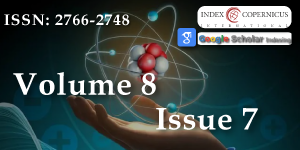Unified Field Theory: Composition of the Universe, Spacetime Motion and the Invariance of the Speed of Light
Main Article Content
Abstract
This paper presents a new perspective on Unified Field Theory, aiming to unify the four fundamental interactions in nature—gravity, electromagnetism, the weak nuclear force, and the strong nuclear force-by redefining the basic concepts of space, time, and motion. The author proposes that the universe consists solely of objects and the space surrounding them, and that all physical phenomena are descriptions of the motion of objects in space and the motion of space itself. Time is defined as the observer's perception of the movement of surrounding space, and the speed of light is viewed as an embodiment of the unification of space and time. By establishing a mathematical model of spiral motion in space, the paper explains the origin of physical concepts and reinterprets fundamental physical quantities such as mass, charge, and energy. The author also explores how the spiral motion of space leads to the unification of the four fundamental forces and discusses the essence of the invariance of the speed of light. This work aims to provide a new theoretical framework that deepens our understanding of the universe's fundamental laws and opens new avenues for the development of physics.
Article Details
Copyright (c) 2025 Zhang X, et al.

This work is licensed under a Creative Commons Attribution 4.0 International License.
1. Rizzo A. Einstein’s last letters: The final path to unified fields. Framework. 2024;1(2):2. Available from: https://www.researchgate.net/profile/Alessandro-Rizzo-19/publication/384733141_Einstein's_Last_Letters_The_Final_Path_to_Unified_Fields/links/6708c9a7e3c0600c7c9b6873/Einsteins-Last-Letters-The-Final-Path-to-Unified-Fields.pdf
2. Salam A. Gauge unification of fundamental forces. Rev Mod Phys. 1980;52(3):525. Available from: https://doi.org/10.1103/RevModPhys.52.525
3. Weinberg S. Conceptual foundations of the unified theory of weak and electromagnetic interactions. Rev Mod Phys. 1980;52(3):515. Available from: https://doi.org/10.1103/RevModPhys.52.515
4. Callan C, Dicke RH, Peebles PJE. Cosmology and Newtonian mechanics. Am J Phys. 1965;33(2):105–108. Available from: https://collaborate.princeton.edu/en/publications/cosmology-and-newtonian-mechanics
5. Einstein A. The general theory of relativity. In: The meaning of relativity. Dordrecht: Springer; 1922;35–56. Available from: https://doi.org/10.1007/978-94-011-6022-3_3
6. Shapiro IS. On the history of the discovery of the Maxwell equations. Sov Phys Usp. 1973;15(5):651–659. Available from: https://iopscience.iop.org/article/10.1070/PU1973v015n05ABEH005038/pdf
7. Kemmer N. Scalar and vector fields. In: Vector analysis: A physicist’s guide to the mathematics of fields in three dimensions. Cambridge: Cambridge University Press; 1977;37–44. Available from: https://books.google.co.in/books/about/Vector_Analysis.html?id=bZw8AAAAIAAJ&redir_esc=y
8. Morse PM, Feshbach H. Gauss’s theorem. In: Methods of theoretical physics, Part I. New York: McGraw-Hill; 1953;37–38.
9. Arfken G. Gauss’s theorem. In: Mathematical methods for physicists. 3rd ed. San Diego: Academic Press; 1985;57–61.
10. Stewart J. Calculus: Early transcendentals. Boston: Cengage Learning; 2012. Available from: https://dzackgarza.com/assets/books/Stewart.pdf
11. Williamson RE, Trotter HF. Multivariable mathematics: Linear algebra, differential equations, calculus. J Math Educ. 1974;11(3):115–121. Available from: https://books.google.co.in/books/about/Multivariable_Mathematics_Linear_Algebra.html?id=EwXvAAAAMAAJ&redir_esc=y
12. Arfken GB, Weber HJ. Mathematical methods for physicists. New York: Academic Press; 1972. Available from: https://msashigri.wordpress.com/wp-content/uploads/2016/11/methods-of-mathemacial-for-physicists.pdf

